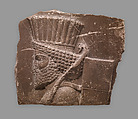Head of a Persian guard
Not on view
The monumental art and architecture of the Achaemenid period are best exemplified by the ruins of Persepolis, the large ceremonial capital of the empire originally built by Darius I (r. 521–486 B.C.) and expanded by his successors. Persepolis is located thirty miles northwest of Shiraz in the southwest Iranian province of Fars. There, structures like the "Hall of One Hundred Columns" and the "Throne Room of Darius and Xerxes" exhibit features characteristic of Achaemenid palace architecture—large square rooms, with ceilings supported by many columns. Some of the columns in the Throne Room have been reconstructed and stand more than sixty-five feet high.
Most characteristic of Achaemenid sculpture are the slabs carved in low relief that decorate the various stairways leading to the ceremonial buildings. This relief portrays the head of an archer, with his quiver and bow resting on his shoulder. The bow terminates in the head of a duck. This fragment recalls the same imagery seen in the famous Frieze of Archers from the palace at Susa, now in the Louvre. Depictions of soldiers were lined up in groups in order to symbolically guard entrances. Archery was the primary method of attack used in Achaemenid warfare, and was also an essential part of the culture as all young men were taught how to shoot an arrow with precision.
Due to rights restrictions, this image cannot be enlarged, viewed at full screen, or downloaded.

